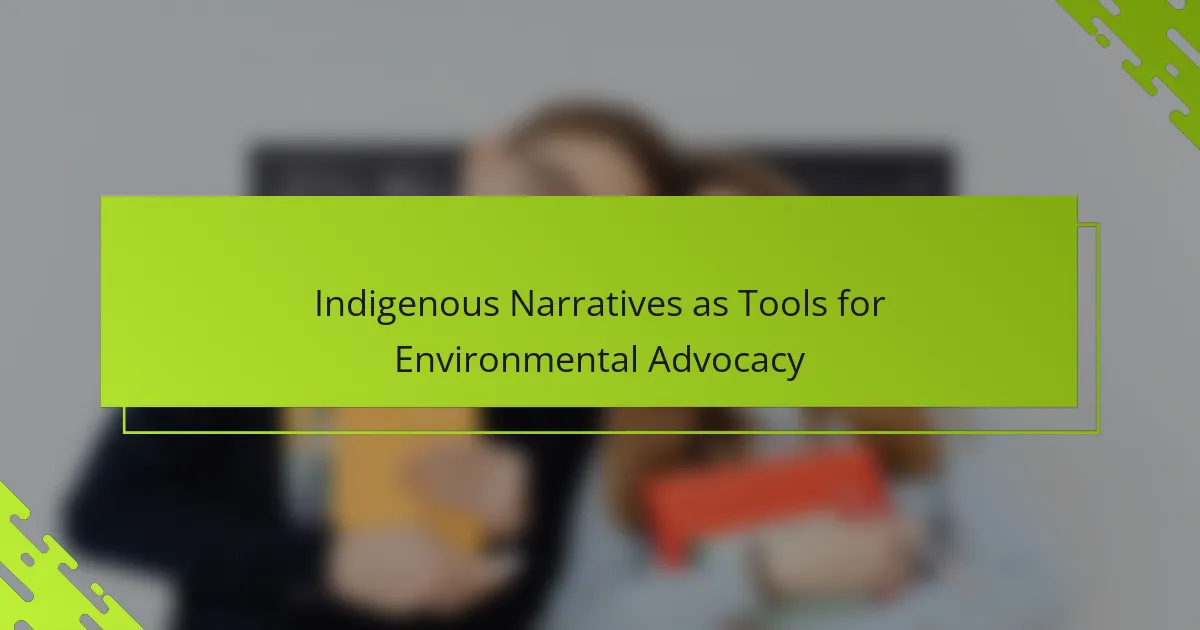Indigenous narratives play a crucial role in environmental advocacy by emphasizing sustainability and respect for nature. These stories integrate traditional ecological knowledge, highlighting practices that promote biodiversity and ecosystem health. They illustrate the interconnectedness of life and foster community responsibility towards environmental protection. By incorporating these narratives into mainstream movements, we can enhance advocacy efforts and elevate marginalized voices in the conversation about climate change and environmental justice.
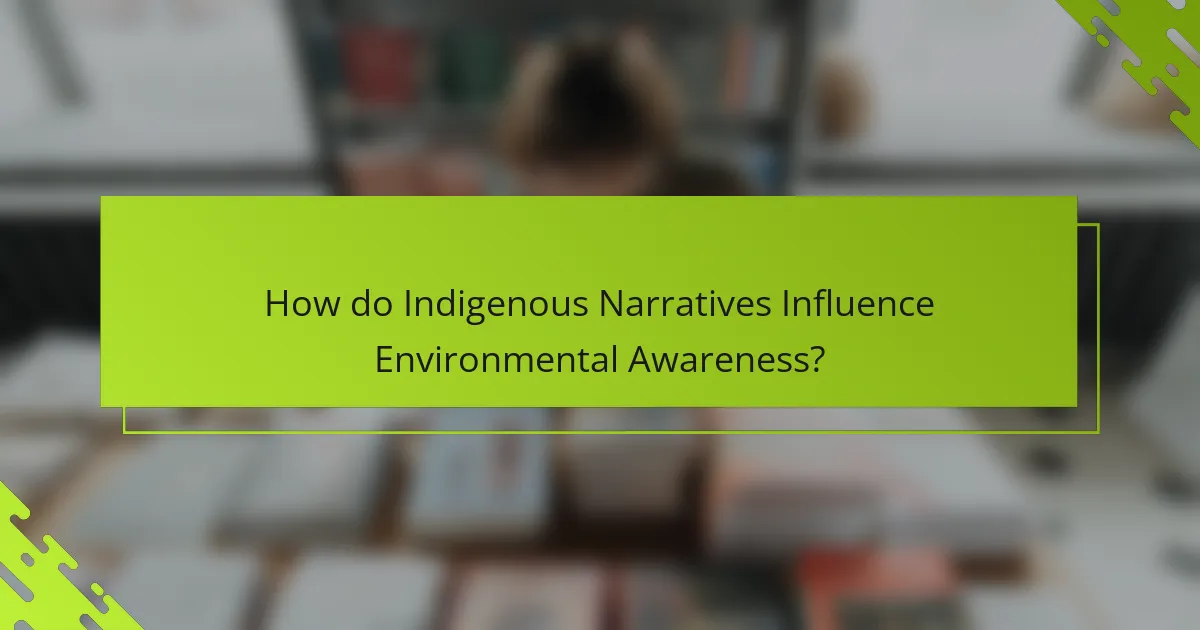
How do Indigenous Narratives Influence Environmental Awareness?
Indigenous narratives significantly enhance environmental awareness by integrating cultural values with ecological stewardship. These stories often convey deep respect for nature and emphasize sustainability.
Indigenous communities utilise traditional knowledge to advocate for environmental protection. This knowledge includes unique practices that foster biodiversity and ecosystem health. For instance, many Indigenous tribes use fire management techniques to prevent wildfires and promote healthy landscapes.
Moreover, these narratives often highlight the interconnectedness of all life forms. They illustrate how human actions impact the environment, fostering a sense of responsibility among listeners. As a result, Indigenous stories serve as powerful tools for environmental advocacy, influencing policies and community actions towards sustainability.
What role do storytelling traditions play in ecological education?
Indigenous narratives play a crucial role in ecological education by fostering a deep connection to the environment. These stories often convey traditional ecological knowledge, emphasizing sustainable practices and respect for nature. They serve as powerful tools for environmental advocacy, promoting awareness and action against ecological degradation. By integrating cultural values with environmental stewardship, Indigenous narratives inspire communities to engage in conservation efforts.
Why are oral histories vital for understanding local ecosystems?
Oral histories are vital for understanding local ecosystems because they preserve Indigenous knowledge and cultural practices. These narratives convey insights about species interactions, seasonal changes, and sustainable resource management. For example, Indigenous communities often share unique observations about local flora and fauna that are not documented in scientific literature. This knowledge enhances biodiversity conservation efforts and informs environmental advocacy by connecting cultural identity with ecological stewardship. As a result, integrating oral histories into environmental strategies fosters a holistic approach to ecosystem management.
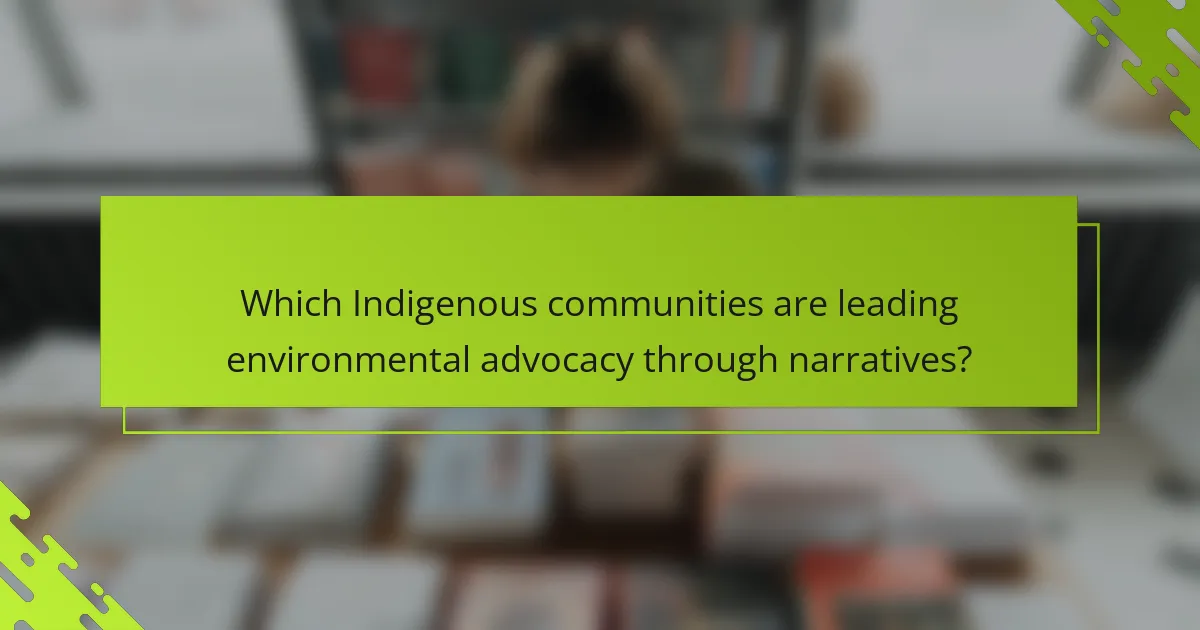
Which Indigenous communities are leading environmental advocacy through narratives?
Indigenous communities like the Navajo Nation, Haudenosaunee Confederacy, and the Māori are leading environmental advocacy through powerful narratives. Their stories connect cultural heritage with environmental stewardship, emphasizing the importance of land and water preservation. These narratives often highlight unique attributes, such as traditional ecological knowledge, which informs sustainable practices. As a result, these communities influence broader environmental policies and raise awareness about climate change. Their advocacy showcases how storytelling can inspire collective action and promote environmental justice.
What unique perspectives do the Haudenosaunee bring to environmental stewardship?
The Haudenosaunee offer unique perspectives on environmental stewardship through their deep-rooted connection to land and sustainability practices. Their worldview emphasizes harmony with nature, viewing the Earth as a living entity deserving respect. This relationship informs their advocacy for biodiversity and ecosystem preservation.
Their governance model, known as the Great Law of Peace, integrates ecological principles, promoting collective responsibility for the environment. The Haudenosaunee also employ traditional ecological knowledge, which encompasses sustainable agricultural methods and resource management, enhancing resilience against climate change.
By sharing their narratives, the Haudenosaunee highlight the importance of Indigenous wisdom in contemporary environmental discussions. This perspective fosters a holistic approach to stewardship that prioritises long-term ecological health over short-term gains.
How do the narratives of the Sámi people address climate change?
The narratives of the Sámi people highlight their deep connection to nature and emphasize the impacts of climate change on their traditional way of life. These stories serve as powerful tools for environmental advocacy, illustrating the importance of preserving the ecosystem. Sámi narratives often incorporate unique attributes of their environment, such as the migration patterns of reindeer, which are threatened by climate change. By sharing their experiences and knowledge, the Sámi raise awareness about climate issues and advocate for sustainable practices that honour their heritage and protect the environment. Their narratives not only reflect cultural identity but also inspire collective action against climate change.

What are the key themes in Indigenous environmental narratives?
Indigenous narratives serve as vital tools for environmental advocacy by emphasizing interconnectedness and stewardship. These narratives often highlight themes of sustainability, respect for nature, and the importance of traditional ecological knowledge. They advocate for a holistic understanding of environmental issues, underscoring the relationship between culture and land. Furthermore, these stories can mobilise communities and influence policy by showcasing the impacts of environmental degradation on Indigenous peoples.
How do concepts of land and identity shape environmental advocacy?
Indigenous narratives shape environmental advocacy by intertwining land and identity, promoting stewardship. These narratives emphasize the deep connection between Indigenous peoples and their ancestral lands, fostering a sense of responsibility toward environmental preservation. By sharing stories and traditions, Indigenous communities highlight the impact of environmental degradation on their cultural identity, urging broader societal engagement in advocacy efforts. This unique perspective not only enriches the discourse on environmental issues but also advocates for sustainable practices rooted in respect for nature.
What role does spirituality play in Indigenous approaches to nature?
Spirituality plays a crucial role in Indigenous approaches to nature by fostering a deep connection between communities and their environment. This relationship is often characterized by respect, reciprocity, and stewardship. Indigenous narratives convey teachings that emphasize the sacredness of land and the interconnectedness of all living beings. These stories serve as tools for environmental advocacy, promoting sustainable practices rooted in cultural values. The unique attribute of these narratives lies in their ability to integrate spiritual beliefs with ecological knowledge, guiding communities in their interactions with nature.
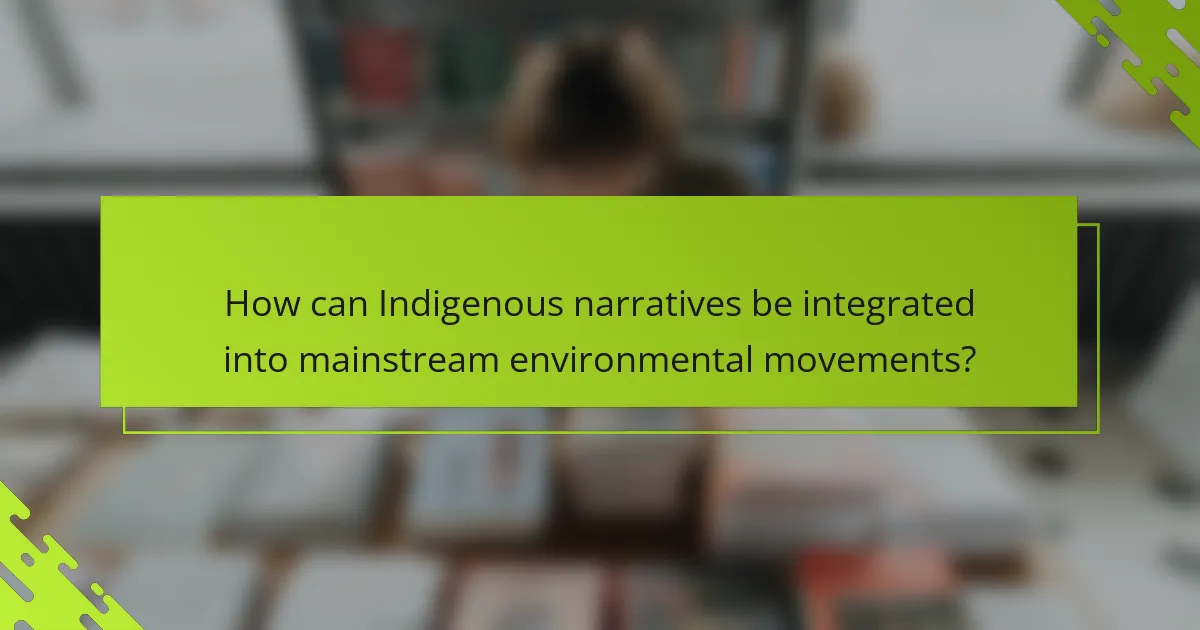
How can Indigenous narratives be integrated into mainstream environmental movements?
Integrating Indigenous narratives into mainstream environmental movements enhances advocacy by promoting diverse perspectives. These narratives provide unique insights into sustainable practices and deep connections to land. Collaborating with Indigenous communities fosters respect for traditional ecological knowledge, enriching environmental strategies. Additionally, incorporating these stories can elevate marginalized voices, creating a more inclusive movement.
What are the benefits of collaborative storytelling between Indigenous and non-Indigenous communities?
Collaborative storytelling between Indigenous and non-Indigenous communities enhances environmental advocacy through shared knowledge and mutual respect. This partnership fosters deeper understanding of Indigenous narratives, which often emphasize sustainable practices and ecological balance.
By integrating diverse perspectives, both communities can address environmental challenges more effectively. Collaborative efforts can lead to innovative solutions that honour traditional ecological knowledge while incorporating modern scientific methods.
Such storytelling initiatives strengthen community ties and promote cultural exchange, ultimately enriching the environmental advocacy landscape. This unique attribute of collaboration highlights the importance of inclusive dialogue in fostering resilience against climate change.
Which platforms are most effective for sharing Indigenous environmental stories?
Social media platforms are most effective for sharing Indigenous environmental stories. Platforms like Instagram, Facebook, and Twitter offer visual storytelling and community engagement, amplifying Indigenous voices.
Instagram’s visual nature allows for impactful imagery that conveys cultural narratives. Facebook fosters community discussions and event promotion, while Twitter enables real-time updates and broader reach.
Additionally, YouTube serves as a platform for documentary-style storytelling, allowing for deeper exploration of environmental issues. Podcasts are emerging as another medium, providing in-depth conversations and personal narratives.
Using these platforms strategically can enhance visibility and foster understanding of Indigenous perspectives on environmental advocacy.
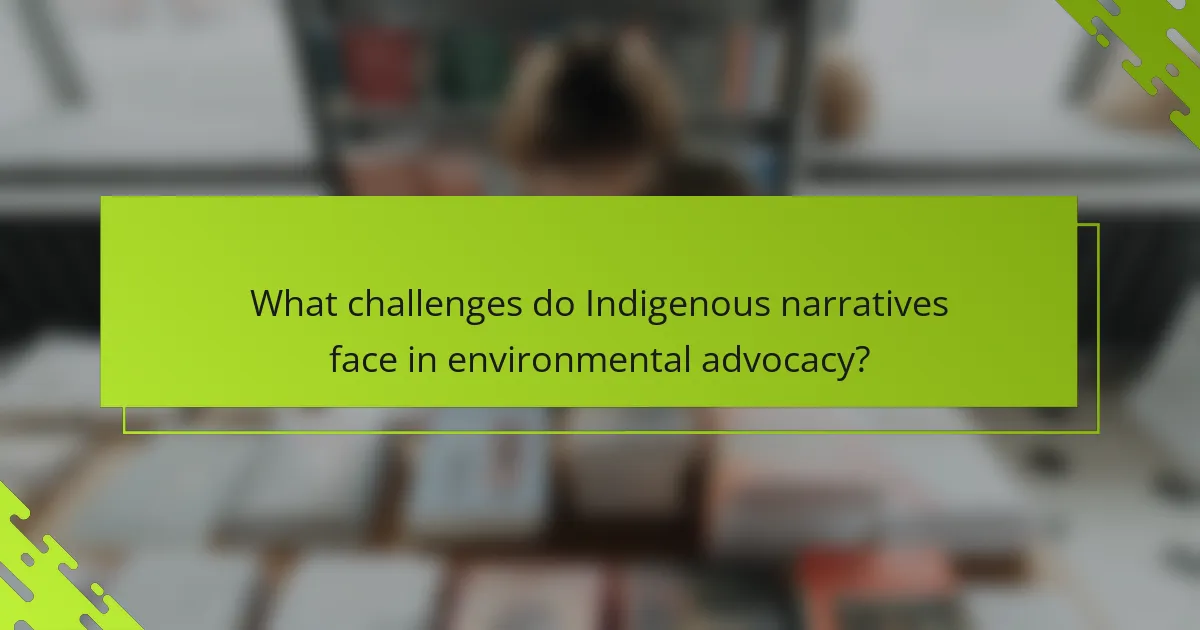
What challenges do Indigenous narratives face in environmental advocacy?
Indigenous narratives face significant challenges in environmental advocacy, including misrepresentation, lack of recognition, and cultural appropriation. These narratives often struggle against dominant Western perspectives that prioritise economic growth over ecological wisdom. Additionally, Indigenous voices are frequently marginalised in policy discussions, limiting their influence on environmental decision-making. As a result, the rich cultural knowledge embedded in these narratives is often overlooked, hindering effective advocacy for sustainable practices.
How do cultural appropriation and misrepresentation impact storytelling?
Cultural appropriation and misrepresentation undermine Indigenous narratives, hindering their role in environmental advocacy. Authentic storytelling requires respect for cultural context and accurate representation. Misrepresentation can lead to distorted perceptions and erode trust between communities. This impacts the effectiveness of Indigenous voices in advocating for environmental protection and sustainability. Engaging with these narratives authentically fosters a deeper understanding of ecological wisdom and promotes respectful collaboration in environmental efforts.
What legal barriers exist for Indigenous voices in environmental policy?
Legal barriers for Indigenous voices in environmental policy include inadequate representation, restrictive regulations, and limited access to decision-making processes. These challenges hinder Indigenous communities from advocating for their rights and environmental stewardship. For instance, many policies fail to recognize Indigenous land rights, which constrains their ability to influence environmental governance. Additionally, bureaucratic complexities often marginalise Indigenous perspectives, resulting in policies that do not reflect their traditional ecological knowledge.
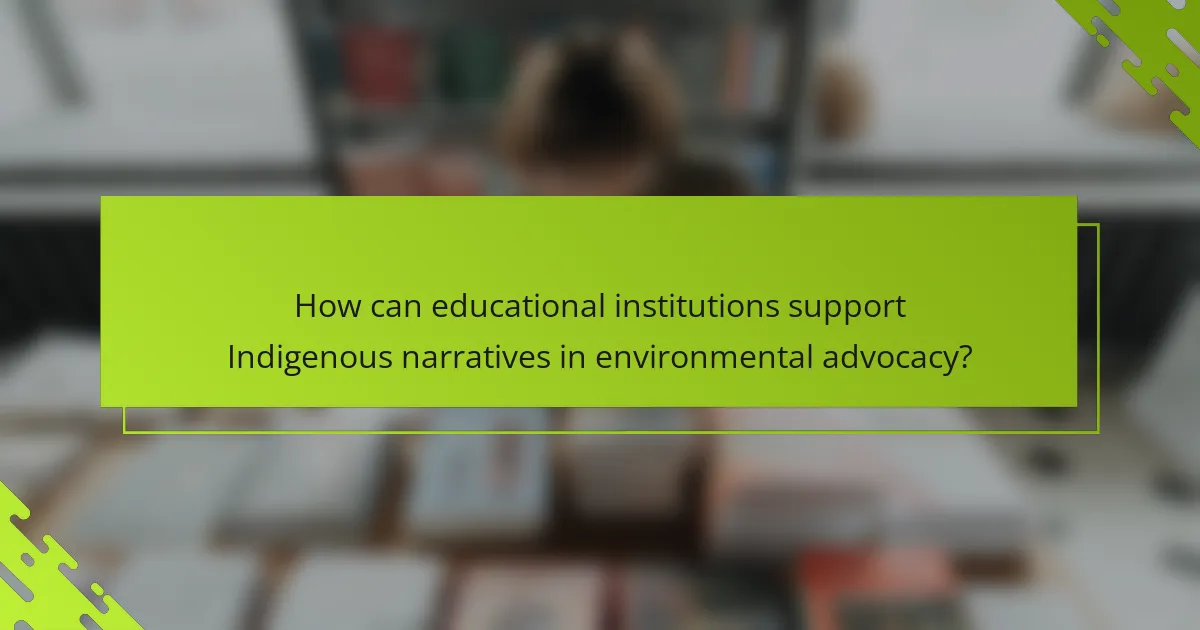
How can educational institutions support Indigenous narratives in environmental advocacy?
Educational institutions can effectively support Indigenous narratives in environmental advocacy by integrating these perspectives into curricula, promoting community partnerships, and facilitating research opportunities.
First, incorporating Indigenous knowledge systems into educational programs enriches students’ understanding of environmental stewardship. For example, courses can highlight traditional ecological knowledge, which emphasizes sustainable practices rooted in Indigenous cultures.
Second, educational institutions should establish partnerships with Indigenous communities to create collaborative projects. These initiatives can engage students in real-world applications of Indigenous environmental practices, fostering mutual respect and understanding.
Lastly, providing research opportunities focused on Indigenous environmental issues empowers students to explore and advocate for these narratives. This approach not only benefits students but also amplifies Indigenous voices in environmental discussions.
What best practices should educators adopt to honor Indigenous perspectives?
Educators should integrate Indigenous narratives into their curricula to honour Indigenous perspectives. This approach fosters respect for Indigenous knowledge and environmental advocacy.
1. Collaborate with Indigenous communities to ensure accurate representation.
2. Include Indigenous stories that highlight relationships with nature.
3. Promote experiential learning through land-based education.
4. Encourage critical discussions about colonial histories and their impacts.
5. Support Indigenous voices in environmental decision-making processes.
How can curricula be adapted to include Indigenous environmental knowledge?
Incorporating Indigenous environmental knowledge into curricula enhances environmental advocacy. This adaptation can be achieved through several strategies.
1. Include Indigenous perspectives in case studies to highlight traditional ecological knowledge.
2. Collaborate with Indigenous communities to develop curriculum materials that reflect their environmental practices.
3. Integrate storytelling methods used by Indigenous cultures to convey environmental lessons.
4. Promote field experiences that immerse students in Indigenous-managed lands, fostering direct engagement with local ecosystems.
5. Evaluate and revise existing curricula to ensure representation of Indigenous voices and values in environmental education.
What common mistakes should be avoided when engaging with Indigenous narratives?
Avoiding common mistakes when engaging with Indigenous narratives is crucial for effective environmental advocacy. Key mistakes include misrepresenting Indigenous voices, oversimplifying complex cultural contexts, and failing to establish genuine partnerships.
Ignoring the unique attributes of Indigenous knowledge can lead to the appropriation of narratives without proper acknowledgment. Additionally, assuming a monolithic perspective on Indigenous cultures disregards the diversity within these communities.
Engaging with Indigenous narratives requires active listening and respect for traditional ecological knowledge, recognizing its value in environmental stewardship. Building relationships based on trust and mutual respect enhances the authenticity of the advocacy efforts.
